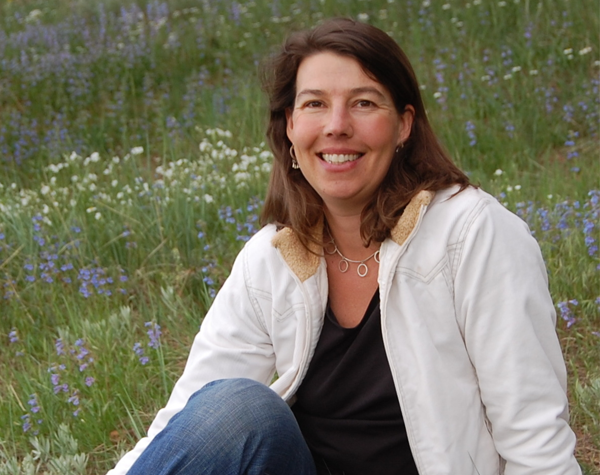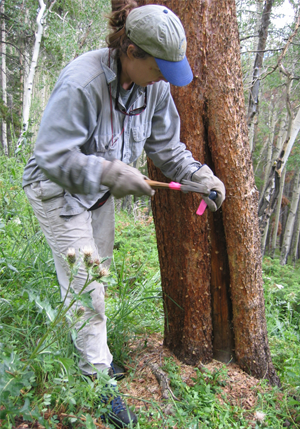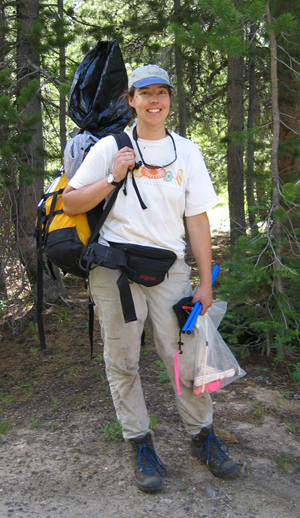Five questions for Tania Schoennagel
After graduating from Dartmouth College, Tania Schoennagel lived in Fourmile Canyon near Boulder and awoke one night to the lights of a fire truck. The local volunteer fire department was fighting a blaze at her neighbor’s house. She was transfixed by the fire and its threat to people as well as its important ecological role in Western forests. After briefly volunteering for the Fourmile Canyon Fire Department and working on a summer trail crew in the Scapegoat Wilderness in Montana (which had burned three years earlier), she pursued a master’s degree in conservation biology at the University of Wisconsin-Madison.
“I initiated an experimental field study looking at native plant responses to severe wildfire and post-fire seeding of non-native grasses, which are often aerially seeded for erosion control,” she said. “Each day that summer, I scaled Icicle Ridge in Leavenworth, Wash., into the black burn and counted green native plants poking out from the black charred ground, and returned looking like a coal miner with a face and arms blackened by soot. I loved it!”
She returned to the University of Wisconsin to pursue a Ph.D. with Monica Turner, a pre-eminent landscape ecologist who studied ecological responses to the 1988 fires in Yellowstone National Park. “She helped me realize I could marry my interest in fire with an exciting career as a research scientist.” Next, Schoennagel undertook post-doc work in the University of Colorado Boulder’s geography department, then became a research scientist at the Institute of Arctic and Alpine Research (INSTAAR) and an adjunct assistant professor in geography.
“Conducting fire ecology field studies virtually outside my office door was an unbelievable opportunity compared to my past experience, where my field sites in Yellowstone National Park were 1,300 miles from my office at the University of Wisconsin,” she said. Her work has centered around the effects of past climate variability and future climate change on forests, regional climate triggers to bark beetle outbreaks in Colorado, and fire mitigation treatments across the United States.
For those interested in finding out more about wildfires and forests in the Rockies, read Schoennagel’s paper titled “The Interaction of Fire, Fuels, and Climate Across Rocky Mountain Forests.” She also recommends reading “The Big Burn” by Timothy Eagan, a Pulitzer Prize-winning journalist who weaves together a historical account of the northern Rockies wildfire of 1910, nascent years of the U.S. Forest Service and development of initial fire management policy. “Wildfire and Americans” by Roger Kennedy, the former director of the National Park Service, addresses more contemporary wildfire issues.
1. The Hayman Fire began 10 years ago this month. Much of the burn area has not seen re-establishment of trees. Generally, how long does it take a forest to “regrow”?
Tree regrowth following the 138,000-acre Hayman fire was remarkably low primarily because the fire severely burned large areas, leaving very few unburned islands of green trees needed to seed the next forest. Because of the lack of seed establishment following the Hayman Fire, some people have speculated that it will take hundreds of years for the next forest to establish. Certainly not all areas that are forested today have always been so, and areas that are meadows today may have been forests in the past. Nonetheless, for a number of reasons, there was a desire to reforest the Hayman Fire area, and about 1 million trees across 17,000 acres were planted recently, so parts of the Hayman Fire area may become forest again within our lifetimes.
2. You’ve done research on beetle kill and wildfires. What has your research discovered and has beetle kill contributed to the numerous fires burning in Colorado?
We conducted a study that measured fuels in high-elevation Lodgepole pine forests on the west side of the Continental Divide that were in different stages since the mountain pine beetle (MPB) attack, then used this field data in computer models to predict how fire behavior might change over time because of beetle kill. Lodegpole pine forests tend to have trees growing more closely together and have a less varied mix of tree species, and on average, experience more severe/extreme fires than Ponderosa pine forests. Our findings generally indicate that in Lodgepole forests with 50 percent tree mortality because of beetle kill, which are in the “red stage” (where the red dead needles mostly remain on the dead trees) and the “grey stage” (where the grey trees are still standing a couple of years after the needles fall), fire may actively burn through the treetops under lower wind speeds than in green stands because red and grey trees hold less moisture and therefore are more flammable. So the chance of active crown fire ignition and spread is expected to be greater in the red and grey stages, compared to green forests. Yet the models suggest that under extreme burning conditions (very dry, gusty winds) when fire is already traveling through the tree tops, differences in fire behavior between green forests and beetle-killed red and grey stages were less marked.
It’s important to note that beetle kill did not cause the fires in Colorado. The severe drought conditions this summer along with hot, extremely dry, and gusty burning conditions are the very important primary causes, obviously along with ignition sources. The beetle kill has been present across the state for many years. It is only when the extreme burning conditions developed that we witnessed big, severe and numerous fires across the state. Within this context, the beetle kill may be making it worse, but we are also operating under some of the worst conditions possible right now. While it is terrible that so many fires are burning this year, once the smoke settles it will be valuable to conduct post-fire studies to examine how beetle kill (and previous fire mitigation treatments) may have affected the spread and severity of the fires, which will contribute to future forest management decisions.
3. Given those conditions, could any forest management policy be effective in reducing or limiting acres burned?
With warmer, drier conditions, we are going to see more forest mortality both due to wildfires and also insect outbreaks. Forest management efforts such as reducing the density of trees (thinning) and/or prescribed burning, which together are called fire mitigation treatments, can be effective in helping fire fighters control wildfire in some instances. However, a lot of variables affect the efficacy of such treatments, and by no means are they a silver bullet against wildfire. First, wildfire would have to actually encounter the treatment to reduce fire risk, which on average is a pretty low-probability event due to the limited size and occurrence of both treatments and fire across a given landscape. Second, an adequate degree of thinning needs to have occurred to reduce the chance of fire burning through the tree tops (called an active crown fire), which is hard to control. Lastly, how the fuels from thinning are subsequently managed has a big impact on potential fire behavior. Removal of the thinned fuels from the site is the most effective in reducing potential wildfire severity, but is very expensive and labor intensive.
In some cases, there are numerous piles of fuels across the landscape that could actually exacerbate wildfire behavior, which was observed in parts of the Fourmile Canyon Fire. Lastly, we have observed from the Hayman and the Fourmile Canyon fires that under extremely dry, gusty burning conditions, previous treatments are often much less effective in reducing severe wildfire behavior than under more moderate weather conditions.
While we shouldn’t abandon fire mitigation efforts, to get the biggest bang for our treatment buck, I believe we need to concentrate the most effective kinds of treatments in and around communities in the wildland-urban interface. I think we need to also spend a lot more effort in directly protecting our values at risk by fireproofing homes rather than simply trying to fireproof the forests, which is a very indirect method of protecting homes from fire with a much lower probability of success.
I led a study that looked at where fire mitigation efforts under the National Fire Plan were being implemented across the western United States. We found that only a small percentage of the area treated was near communities in the wildland-urban interface. The discussions that ensued focused on the difficulty of public land management agencies charged with trying to reduce wildfire risk on public lands, when the primary values at risk are homes. So while wildland fire has emerged as a public land management debate, it in fact is essentially a private property protection issue, so in my mind we have a major mismatch between agency responsibility and land ownership.
We need more proactive measures to help develop more fire-resilient human communities. The first line of defense would be curbing development in the forest. Five counties in Colorado are in the top 20 most-developed wildland-urban interfaces in the West. Wildfire risks and costs are directly correlated with the number of homes in the line of fire, so if we reduce the development in the forest, we reduce the wildfire risk. Another idea is to create incentives and restrictions that modify the home ignition zone, the house and its immediate surroundings through home insurance policies, building codes, etc. Last would be designing communities that are safer for fire fighters to defend and easier for home owners to evacuate.
4. What worries you most about the future of our forests? What do you find heartening?
The coming decades will be a period of rapid forest change with substantial tree mortality due to wildfire and insects. We are not used to such rapid change in our forest landscapes, which during our lifetimes have mostly exhibited gradual, slow changes. With recent and expected warming trends, I am concerned that what used to be anomalous fire years are becoming the new norm: 2002 was the driest summer on record in Colorado, which was the year of the Hayman Fire, which currently stands as the largest fire in Colorado. But now only 10 years later, 2012 is shaping up to be as dry, or drier, with multiple major wildfires burning across the state in June. Although it is still fairly early in what is becoming a longer fire season, 2012 may exceed the relatively briefly held record of 2002 as the worst fire year in Colorado. What I find heartening, however, is that while some forests seem extremely vulnerable to warming -- for example, Whitebark pine forests -- other forests such as Lodgepole pine appear to be fairly resilient to severe wildfires and insect outbreaks. I also think that human communities are very resilient and that we will be able to adapt as necessary to the inevitable wildfires.
5. What is a favorite possession you keep in your office and how did you acquire it?
A stack of fire-scarred wedges. These are the wood samples that we collect in the field from trees that were burned in the past to help us understand fire history of a forest. I love these scars because they remind me of being in the field, which involves lots of hard work hiking off trail to get to remote sites. I always feel part detective/part warrior out in the field, fanning out across the landscape chasing obscure kernels of information that help us tell a story about a forest that hopefully has broader meaning to other scientists, the public or policy makers.
I also just love uncovering the hidden secrets that tree rings hold. Using a bow saw, we saw vigorously, back-and-forth, back-and-forth, back-and-forth, with sweat pouring down our temples, until our saw cuts deep enough to capture the tip of the fire scar embedded within the tree. This holds the secret about past burns, growth patterns and hidden injuries. We stop sawing, breathing hard, and chisel out the 2-inch wedge we cut from the side of the tree, then expectantly, we pop it free, hold the hefty, fresh-scented piece of wood in our hands, and look. “Ah, it burned here, about 120 years ago, and again just before that.” “Wow, it really grew fast here. Look at that!” “I see bluestain fungus invaded the tree then, but it didn’t die.” We can read the tree’s history like a legend. It is fascinating and beautiful, and the stack of fire-scarred wedges in my office always takes me back to those sweaty moments of hard-won discovery.




